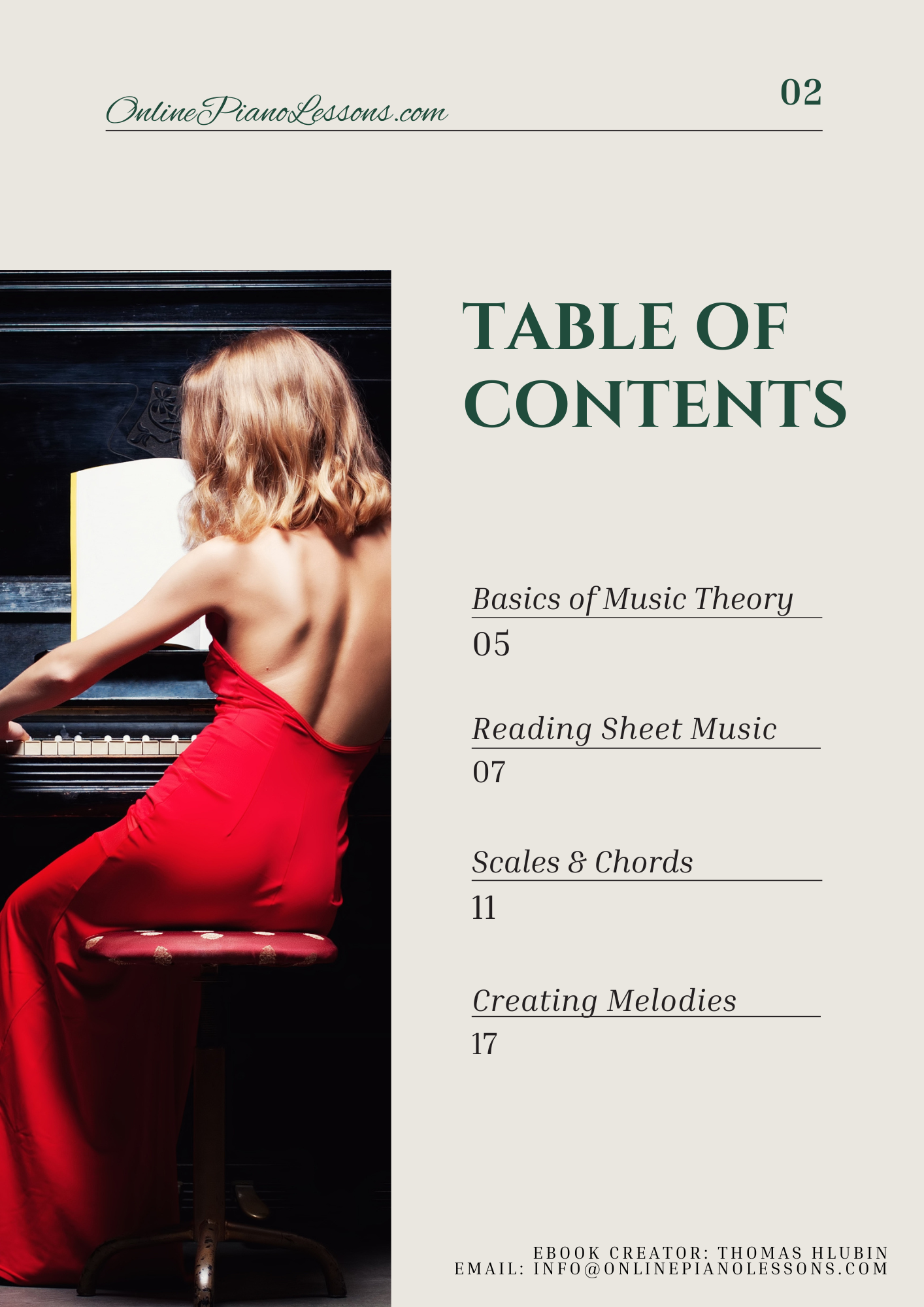The major third is one of the most important building blocks in music. On the piano, the major third defines whether a chord sounds bright and stable (major) or darker and more ambiguous (minor). Understanding the major third will instantly improve your chord voicings, ear training, improvisation, and harmony knowledge. This guide explains what the major third is on the piano, how to find and use it, why it matters, and practical exercises to make it part of your playing.
What Is the Major Third?
A major third is the interval spanning two whole steps (four semitones). On the piano, if you start on any key, the major third is the note four half steps higher. For example:
- From C, a major third is E (C → C♯ → D → D♯ → E).
- From G, a major third is B (G → G♯ → A → A♯ → B).
Because a major third is the distance between the root and the third of a major chord, it determines the chord’s quality: a root plus a major third and a perfect fifth is a major triad. In other words, the major third is the ingredient that makes major chords sound “happy” or “bright” on the piano.
Major Third Versus Minor Third
To fully understand the major third, contrast it with the minor third:
- Major third = 4 semitones (two whole steps).
- Minor third = 3 semitones (one and a half steps).
On the piano, shifting the third by a single semitone changes the chord’s character dramatically: C–E–G is C major (major third present), while C–E♭–G is C minor (minor third present). Training your ear to recognize that one-semitone difference is one of the most valuable skills in piano playing.
How to Find the Major Third Quickly on the Piano
Here are practical shortcuts for finding major thirds at the keyboard:
- Count semitones: Move four keys (including black keys) upward from the root.
- Use patterns: On white-key roots, visualize where the third usually sits—E is the major third of C, B is the major third of G, etc.
- Two-note shape memory: Practice playing root–third pairs across the keyboard to build instant recognition.
- Inversions: Recognize a major third also as an inverted minor sixth (e.g., C–E inverted is E–C, which is a minor sixth). That helps when playing voicings and inversions.
These simple tricks make locating major thirds on the piano fast and intuitive.
Why the Major Third Is So Important on the Piano
The major third matters because it:
- Defines chord quality: Major vs. minor depends on the third.
- Guides voice leading: When moving between chords, the third often resolves or moves stepwise, creating harmonic clarity.
- Shapes melody and harmony: Melodic lines frequently target chord thirds; pianists use major thirds to outline harmony.
- Informs voicing choices: In extended chords, the third and seventh are guide tones—knowing the major third’s role helps you choose which notes to include or omit on the piano.
Major Third in Chords and Progressions
On the piano, chords are named and built using intervals, so the major third is central:
- Major triad: 1 — 3 (major third) — 5
- Major seventh: 1 — 3 — 5 — 7 (major third remains crucial)
- Dominant chords: The major third in a V chord creates the tension that typically resolves to the tonic (I). For example, G7 (G–B–D–F) contains B, the major third, which pulls to C (the tonic) in many progressions.
Understanding how the major third functions in progressions (ii–V–I, IV–V–I, etc.) helps pianists voice chords efficiently. When comping, prioritize the third and seventh in your right-hand voicings to outline the harmony while a bass player or left hand supplies the root.
Voice Leading and the Major Third
Voice leading is the art of moving chord tones smoothly between chords. The major third often moves by small steps to the next chord’s chord tones, producing smooth lines. Example in C major:
- Progression: Dm7 → G7 → Cmaj7
- Guide-tone motion: F (3rd of Dm7) → B (3rd of G7) → E (3rd of Cmaj7)
Even though those are not all major thirds relative to the root, the point is the 3rd of each chord (which may be a major or minor third interval from its root) acts as a guide tone. Recognizing and controlling how the major third behaves in each chord makes your piano playing sound professional and musical.
Major Third Ear Training on the Piano
Train your ear to hear major thirds using this routine:
- Play two notes separated by a major third (e.g., C and E). Sing the interval out loud.
- Compare with a minor third (C and E♭) so your ear learns the contrast.
- Practice identifying thirds in simple songs (most hymns and pop ballads emphasize thirds).
- Play root–third pairs randomly and call out whether the third is major or minor.
Within weeks, you’ll begin to identify major thirds instantly while playing or listening—an essential skill for improvisation and harmonization on the piano.
Practical Exercises for the Major Third on the Piano
Use these exercises daily to internalize the major third:
- Root–third patterns: Pick each root (C to B) and play its major third, then its minor third. Repeat both hands separately.
- Arpeggio focus: Play major triads across the keyboard emphasizing the 1–3 motion.
- Inversion drill: Practice triad inversions and sing the third while holding the root.
- Chord comping: Comp a simple progression (C–G–Am–F) but emphasize the thirds in the right hand.
- Melodic targeting: Compose 4-bar phrases that target the third of each underlying chord on strong beats.
These drills build both technical skill and harmonic intuition around the major third.
Major Third in Different Genres on the Piano
- Classical: Composers use the major third for bright, triumphant chords—think major key cadences and fanfares.
- Pop: Major thirds are central to catchy, uplifting hooks and triadic harmony.
- Jazz: Thirds are guide tones; pianists use major thirds in shell voicings and comp patterns.
- Blues/Rock: The interplay between major and minor thirds (the “blue note” concept) creates emotional ambiguity and color.
Knowing how the major third behaves stylistically helps you adapt your touch, voicing, and dynamics to different musical contexts on the piano.
Common Mistakes and How to Fix Them
Mistakes beginners make with the major third on the piano include:
- Ignoring context: Playing a major third where a minor third is required (or vice versa). Fix: analyze the chord function first.
- Poor intonation in voicings: muddy right-hand voicings that hide the third. Fix: use clearer voicings and omit the 5th if necessary.
- Weak ear for thirds: not distinguishing major vs. minor by ear. Fix: daily ear training and root–third drills.
- Overemphasis of thirds: playing thirds too loudly and losing balance. Fix: control dynamics, let bass guide the harmony.
Addressing these fixes will make your piano playing cleaner and more harmonically informed.
Applying the Major Third Creatively
Once you’re comfortable, use the major third creatively:
- Modal mixture: borrow a major third from the parallel major to brighten a minor key passage.
- Chromatic passing: slide a major third chromatically to create tension before resolving.
- Voice swapping: move the third between hands for textural contrast.
- Pedal tones: hold a sustained root in the left hand while changing thirds on top to alter color.
These techniques let the major third be not only functional but expressive.
Final Thoughts
The major third on the piano is small in distance but huge in impact. It’s the note that tells you whether a chord smiles or sighs, whether a progression brightens or darkens. Commit to the exercises here, train your ear, and watch how everything you play becomes clearer, more intentional, and more expressive. Once the major third lives under your fingers and in your ear, the piano starts to respond to your musical choices with precision and color.
FAQ
What is a major third on the piano?
A major third is the interval of four semitones (two whole steps). On piano, from C to E or G to B are examples. The major third determines a chord’s major quality.
How do I find a major third quickly?
Move four half-steps (count keys including black keys) up from the root. Visual pattern practice speeds this up.
Why is the major third important?
It defines major harmony, guides voice leading, and shapes melodic and harmonic expression on the piano.
How do I practice hearing major thirds?
Compare major and minor thirds daily, sing intervals, and do root–third identification drills.
Can the major third be omitted in a chord?
Yes—some voicings omit the third for color (sus chords, power chords), but omitting it removes the chord’s major/minor identity.
How does the major third function in jazz piano?
It’s a guide tone, often paired with the seventh in shell voicings; its motion helps define harmonic function in ii–V–I progressions.







 Hi, I'm Thomas, Pianist Composer,
Hi, I'm Thomas, Pianist Composer,  I love playing piano, creating new melodies and songs, and further developing my online piano course and making updates/additions to my site OnlinePianoLessons.com!
I love playing piano, creating new melodies and songs, and further developing my online piano course and making updates/additions to my site OnlinePianoLessons.com!  Now that is what I call fun!
Now that is what I call fun!
